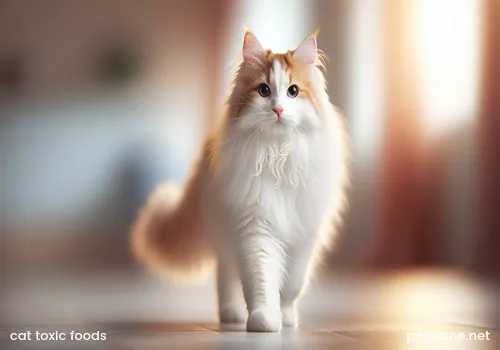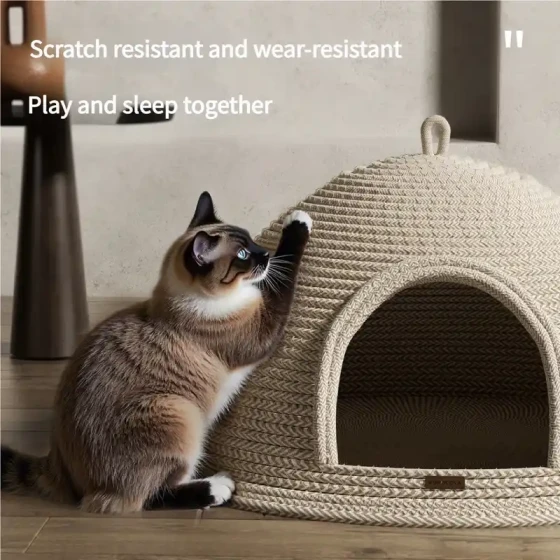Things that are fatal if cats eat_toxic foods that cat-owning households must beware of
The curiosity of cats always makes pet owners both love and fear them, especially when they show interest in human food. However, many of the foods we commonly enjoy pose hidden dangers to cats and can even be fatal. As responsible pet owners, knowing which foods are toxic to cats and staying vigilant is key to protecting their health and happiness.

Overall, many human foods can harm cats, causing anything from mild gastrointestinal discomfort to severe organ damage and even death. Among them, onions, garlic, chocolate, grapes and raisins, alcohol, raw dough, and foods containing xylitol are especially dangerous "no-go zones" for cats.
Foods That Are Fatal if Cats Eat? Dangerous Foods Cat-Owning Households Must Beware
Although saying "fatal if eaten" may be somewhat exaggerated, there are indeed several common foods that are highly toxic to cats. Even consuming a small amount can trigger severe or life-threatening consequences. Knowing these dangerous foods and taking preventive measures is of utmost importance to ensure cat safety.
1. Allium Vegetables: The "Killers" Hidden in Your Kitchen
Onions, garlic, scallions, chives, and other allium plants are potentially deadly threats to cats. These foods contain sulfur compounds such as propyl disulfide and allyl disulfide, which damage cats’ red blood cells, leading to hemolytic anemia. Simply put, cats’ red blood cells break down massively, preventing proper oxygen transport, causing weakness, lethargy, loss of appetite, pale gums, and even orange to dark red urine (hematuria). Whether raw, cooked, dried, or used as seasoning in food, allium vegetables are harmful to cats. Some processed foods, like baby food or meat products, may contain onion or garlic powder, so pet owners must carefully check ingredient lists before feeding any human foods to cats.
Studies show that when an adult cat consumes onions equivalent to 1g per kg of body weight, severe anemia may occur. Although cats usually avoid eating pungent foods actively, if they accidentally lick food residues containing allium components, there is still a risk of poisoning.
2. Chocolate: Sweet Temptation, Deadly Poison
Chocolate we love is truly a "poison" to cats. It contains theobromine and caffeine, both methylxanthines. Cats metabolize these substances far less efficiently than humans and dogs, so even a small dose can cause poisoning. Theobromine stimulates the cat’s central nervous system and heart muscle, leading to vomiting, diarrhea, thirst, arrhythmia, muscle tremors, and in severe cases, seizures, coma, or death. The higher the cocoa content, the more theobromine is present, thus dark and baking chocolate are more dangerous than milk or white chocolate.
Data shows that about 1.3 mg of baking chocolate or 13 mg of milk chocolate per kg of a cat's body weight can cause poisoning. Symptoms typically appear within hours after consumption, and severe cases can be fatal within 1-2 days. If a cat accidentally eats chocolate, immediate veterinary care is essential to perform emergency measures like inducing vomiting and gastric lavage to reduce theobromine absorption.
3. Grapes and Raisins: Small Fruits, Huge Danger
The toxic mechanism of grapes and raisins in cats is not fully understood, but research indicates that even a small amount can trigger acute kidney failure and possibly death. Vomiting, diarrhea, loss of appetite, depression, weakness, decreased or absent urination may all be signs of grape or raisin poisoning. It is worth noting that tartaric acid or potassium bitartrate in grape skins is considered a potential cause of kidney failure in cats and dogs.
Though cats appear less susceptible to grape and raisin poisoning than dogs, given the potentially severe consequences, any amount of grapes or raisins should be strictly avoided in cat diets.
4. Alcohol: Even a Drop Is Too Much
Alcohol is highly toxic to cats. Their bodies cannot effectively metabolize alcohol, and even tiny amounts can severely damage their nervous system and liver. Alcohol consumption can cause vomiting, diarrhea, disorientation, respiratory difficulties, tremors, coma, and even death. Besides alcoholic beverages, foods, medicines, or household products containing alcohol can pose threats, so owners need to be extremely cautious.
It is said that as little as two teaspoons of whiskey could cause a 5-pound cat to become comatose, and a bit more could be fatal. This underscores the high toxicity of alcohol to cats.
5. Raw Dough: Expanding Crisis
Raw dough containing yeast continues to ferment in the cat’s stomach, producing gas that causes gastric bloating and abdominal pain. Additionally, fermentation produces alcohol, which may lead to alcohol poisoning. Cats ingesting raw dough may show vomiting, diarrhea, abdominal swelling, weakness, and in severe cases, gastric rupture or intestinal obstruction, which can be life-threatening.
6. Xylitol: The Invisible Sweet Trap
Xylitol is a common artificial sweetener found in sugar-free gum, candies, baked goods, peanut butter, and some diabetic-specific foods. In dogs, xylitol causes rapid insulin release, leading to severe hypoglycemia and liver failure. Although cats are less sensitive to xylitol than dogs, there is still potential danger. Xylitol may cause hypoglycemia in cats, with symptoms such as weakness, vomiting, loss of coordination, and if untreated, liver damage. Therefore, foods containing xylitol should also be kept away from cats.
Other Foods to Beware Of
Besides the above “blacklist” items, there are other foods that may not be "fatal" but still cause potential health risks to cats, requiring pet owners’ attention:
- Raw meat, raw fish, and raw eggs: May contain harmful bacteria like Salmonella and E. coli, as well as parasites, causing vomiting, diarrhea, lethargy. Avidin in raw egg whites interferes with cats’ biotin (vitamin B7) absorption, leading to skin and coat issues. An enzyme in raw fish can destroy vitamin B1 in cats, causing deficiencies with prolonged consumption.
- Cooked bones: Cooked bones become brittle and fragment into sharp pieces, potentially injuring cats’ mouths, esophagus, gastrointestinal tract, or causing choking and intestinal blockage.
- Milk and dairy products: Most adult cats lack lactase and cannot digest lactose in milk, causing diarrhea and gastrointestinal discomfort (lactose intolerance).
- High-fat foods: Excessive fats may cause vomiting, diarrhea, and even pancreatitis in cats.
- High-salt foods: Excess salt overburdens cat kidneys, causing electrolyte imbalances and symptoms such as vomiting, diarrhea, tremors, seizures.
- Coffee, tea, and caffeinated drinks: Like chocolate, caffeine stimulates cats’ nervous system and heart, causing restlessness, rapid breathing, palpitations, muscle tremors.
- Avocado: Contains a substance called Persin, which may cause vomiting and diarrhea in cats.
- Nuts: Some nuts like macadamia nuts and walnuts can be toxic to cats, resulting in weakness, vomiting, and tremors. Their high fat content may cause gastrointestinal upset and pose choking hazards.
- Citrus fruits: Citrus fruits (e.g., lemons, oranges) contain citric acid and essential oils which may irritate cats’ gastrointestinal tract, causing vomiting and diarrhea.
How to Prevent Cats from Eating Dangerous Foods?
Prevention is always better than cure. As pet owners, we can take the following measures to minimize the risk of cats ingesting dangerous foods:
- Store food properly: Keep all toxic foods out of reach of cats, such as in closed cabinets or high places.
- Clean up food residues: Promptly clean food scraps from tables and kitchen counters to avoid cats licking them.
- Watch the trash bins: Use trash cans with lids to prevent cats from rummaging for food.
- Check food ingredients: Before feeding any human food to cats (though frequent feeding is not recommended), carefully read ingredient lists to confirm no harmful substances are present.
- Educate family members: Inform all household members about which foods are harmful to cats and emphasize not to feed them human food casually.
- Be cautious with visitors: Inform friends and relatives in advance not to feed cats during visits.
What to Do If a Cat Eats Dangerous Food by Mistake?
If an unfortunate incident of a cat eating dangerous food occurs, stay calm and take the following steps immediately:
- Contact a veterinarian immediately: This is the most important step! Quickly contact your veterinarian or the nearest pet emergency hospital, informing them about what and how much the cat ate and any symptoms displayed. If possible, bring a sample or packaging of the consumed food to the hospital.
- Do not induce vomiting on your own: Unless instructed by a vet, do not attempt to make the cat vomit. In some cases, inducing vomiting may cause more harm.
- Observe your cat’s symptoms: Monitor the cat’s mental state, appetite, stools, vomiting, etc., and record information to provide the vet with detailed data.
- Follow veterinary instructions: Strictly adhere to the vet's guidance for subsequent treatment and care.
Frequently Asked Questions
-
Why can’t cats eat onions and garlic?
Onions and garlic contain sulfur compounds that destroy cats’ red blood cells, causing hemolytic anemia, which hinders oxygen delivery and can be life-threatening. -
What happens if a cat eats chocolate?
Theobromine and caffeine in chocolate stimulate the cat’s nervous system and heart, causing vomiting, diarrhea, arrhythmia, muscle tremors, and in severe cases, seizures, coma, or death. -
Can cats eat grapes or raisins?
No. Grapes and raisins may cause acute kidney failure in cats, with risk present even at small amounts. -
Can cats drink milk?
Most adult cats are lactose intolerant and drinking milk can cause diarrhea and digestive discomfort. -
Can cats eat raw meat or raw fish?
Not recommended. Raw meat and fish may contain parasites and bacteria causing illness. Long-term raw fish consumption can lead to vitamin B1 deficiency. -
Can cats eat cooked bones?
Not recommended. Cooked bones easily splinter and may injure cats’ digestive tracts. -
How soon do symptoms appear after a cat eats dangerous food?
The onset time varies by food type, amount ingested, and individual cat differences. Some poisoning symptoms appear within hours, others may be delayed for days.
Conclusion
Raising cats requires not only love and patience but also scientific knowledge and careful care. Understanding which foods are dangerous to cats and staying vigilant is essential to protect your furry friend’s health. For your cat’s well-being and safety, ensure they stay away from these "no-go zones" and provide safe, balanced cat food so they can happily accompany us, enjoying a wonderful feline life.

-560x560.webp)

